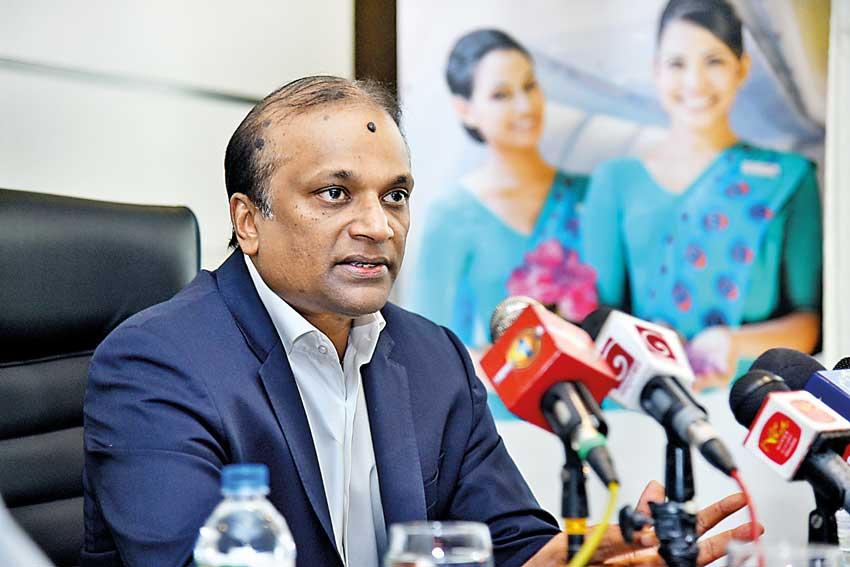Reply To:
Name - Reply Comment

Ashok Pathirage
Pic by Samantha Perera
By Indika Sakalasooriya
National carrier SriLankan Airlines expects to go forward as a leaner operation in the post-COVID-19 environment while trimming its debt exposure running into a billion dollars, according to its Chairman
Ashok Pathirage.
After assuming duties as SriLankan Chairman in January, Softlogic-fame Pathirage had presented a business plan to the Cabinet of Ministers to turnaround the struggling state-owned airline within a year, largely by way of fresh cash injections and restructuring of debt.
However, the COVID-19 outbreak in March has significantly altered this plan and the airline is now faced with taking some hard business decisions from scaling down its operations to a possible voluntary retirement scheme (VRS) for its employees in the future.
The airline has already sent over 900 of its employees on no-pay leave, including pilots and reduced salaries of those who are paid more than Rs.100,000. Pathirage said they are awaiting the approval for a VRS to retrench at least 500 of the staff.
The airline currently has about 7,000 employees, including those who are on no-pay leave and incurs a salary bill of US $ 7 million per month. The cost-saving form the 900 staff sent on no-pay leave is estimated at US $ 30 million per annum.
Debt restructuring
Pathirage, in his first encounter with the media as Chairman of SriLankan, yesterday said he and the new director board of the airline didn’t want to continue to sit on a billion-dollar debt.
Only a fraction of SriLankan’s debt is foreign. Majority of its debt is to its main shareholder, the Sri Lankan government. The airline owes about US $ 400 million to the state-owned Bank of Ceylon (BOC) and People’s Bank and US $ 275 million to the state-run Ceylon Petroleum Corporation (CPC). Further, a sovereign guarantee on a bond sale by the airline worth of US $ 175 million
remains outstanding.
Under its foreign liabilities, the airline has a US $ 30 million loan with Credit Suisse. Pathirage said with the backing of the government, the airline is currently discussing with the two state banks to restructure the debt on a long-term basis with grace periods.
At least for the last eight years, SriLankan has been rolling over these short-term loans with the two banks, only servicing the interest component. The interest cost per annum is estimated at US $ 70 million.
“We want to have a proper cash flow so we can find a way out of this and eventually we can pay this debt out,” Pathirage said.
He also said the government has agreed to withdraw the withholding tax (WHT) applicable on aviation services. With this, the airline is poised to save US $ 30-40 million per annum. The airline’s accumulated WHT as of now amounts to US $ 80 million, which has just been a book entry and never paid. Pathirage said the withdrawal of WHT will prop up SriLankan’s P&L.
Fresh cash infusions
SriLankan had received the Cabinet approval for a fresh cash infusion. Although Pathirage did not reveal how much they asked from the government under its pre-COVID business plan, he now says the airline is negotiating with BOC and People’s Bank for a fresh cash infusion of US $ 75 million. “With all our commitments, we require this money until we start reasonable level of business,” he said.
He also said SriLankan on its own is looking at ways of raising money with its two profitable businesses—SriLankan Catering and ground handling—under its umbrella. The catering business generates about Rs.5 billion per annum and ground handling makes about US $ 75 million per annum to the group. “Put together, these two are contributing about Rs.15 billion into the group bottom line but the airline loses all of it,” Pathirage said.
Meanwhile, SriLankan has been talking to some foreign investment banks to borrow overseas, Pathirage revealed. However, no further details were given.
Post-COVID operations
From a revenue perspective, SriLankan Airlines has been the largest revenue earner for the government. It is a billion-dollar revenue company though it has lost money continuously. Last year, the airline lost about US $ 130 million. Now with COVID-19 impacting business, the airline is generating less than US $ 20 million a month, with limited operations.
The airline plans to resume its operations from August 1, in line with the government’s plan to reopen the airport for incoming passengers and tourists. SriLankan Airlines management believes the airline’s post-COVID operations would be different, as it may not operate to the same destinations with same frequencies before March.
For example, SriLankan operated 140 flights per week to India before March and that country accounted for roughly 40 percent of the airline’s revenue. However, from August 1, SriLankan may not operate that many flights to India, given the coronavirus situation there.
But the airline is increasing frequencies to destinations with lower risk, such as China and adding new destinations such as Seoul, South Korea and
Sydney, Australia.
SriLankan also expects its yields to come down in the post-COVID environment, with airlines competing for the limited traffic.
“Things are changing so rapidly today. It is very difficult to come up with a firm plan. We assume that by December, about 40 percent of business would be back to normal and by March next year, we would be able to do 70 percent of what we used to do. The recovery year is going to be 2021,”
Pathirage remarked.